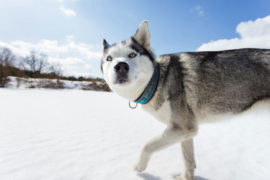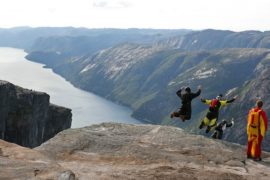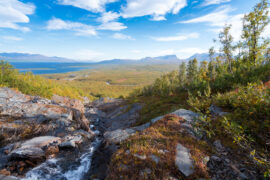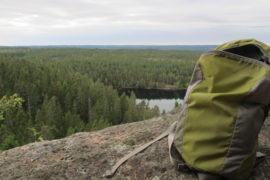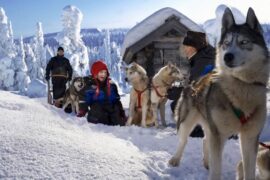Nordic walking originated in Finland as an enhanced walking technique that uses poles to provide a full work-out for your whole body as well as your legs.
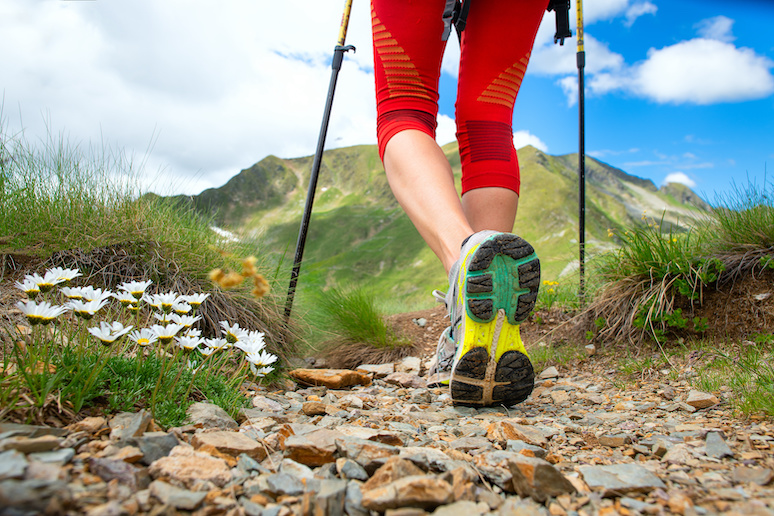
The sport quickly spread to other Scandinavian countries and is now popular throughout the US and Europe.
Nordic walking uses specially designed poles which were adapted from those used by cross-country skiers.
The key differences between Nordic walking, regular walking and hiking is that Nordic walkers use the muscles in their upper body as well as their legs to provide a work-out that is similar to skiing.
And if you perfect the correct technique, Nordic walking can provide a whole range of health benefits over and above regular walking and hiking.
What gear do you need?
First and foremost, you need a pair of Nordic walking poles. These don’t have to be expensive – see our guide for all you need to know about the different types of Nordic pole, which brands are good and where to buy them.
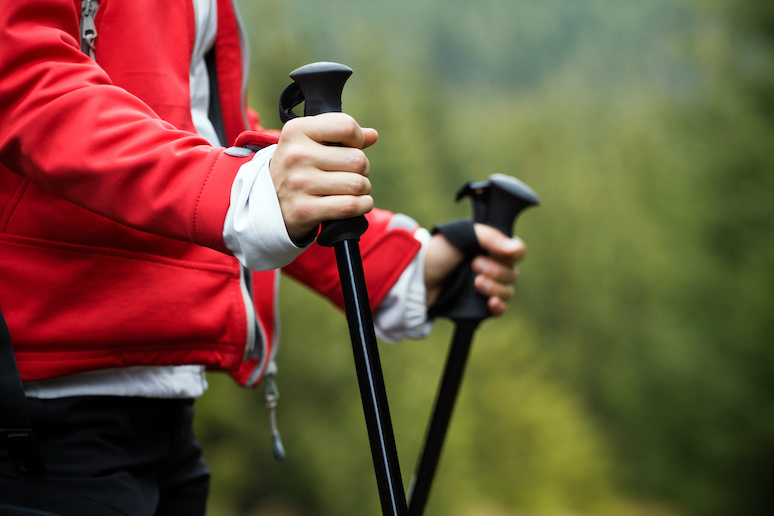
Apart from the poles, you’ll need the same sort of gear you would take on a regular hike – good walking boots and appropriate clothing. Of course, what gear you need depends on where you’re walking and what the weather conditions are.
Nordic walking can be done on any kind of terrain, from flat forests to hills and valleys, so come equipped for the terrain and the climate.
We’ve also seen plenty of people doing Nordic walking in the centre of busy cities – there’s no judgement when it comes to getting exercise in Scandinavia!
When choosing footwear, flexibility is key to give you an active push-off – and the lighter the boot the better.
If you’re walking over rough terrain you may prefer boots with good ankle support, but for most ground, lightweight waterproof flexible footwear is best.
Decathlon’s Amazon store is a good place to look for reasonably priced Nordic walking boots and shoes.
Is Nordic walking any good for you?
Of course all walking is good for you, but the chief advantage that Nordic walking has over regular walking is that it exercises the upper body as well as the legs.
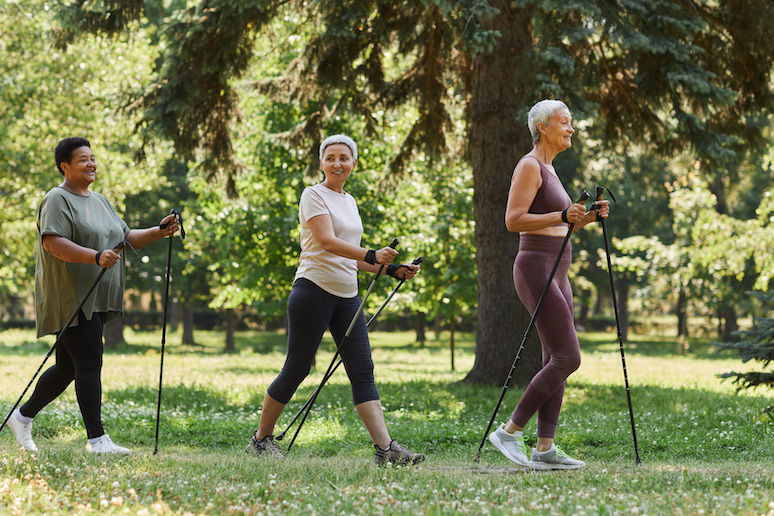
The health benefits of Nordic walking can include improved posture, increased muscle strength and decreased stress levels.
It’s a weight-bearing, cardiovascular activity that is good for the heart and the bones and strengthens the core.
Studies suggest that Nordic walking burns more calories than regular walking and it can also help to tone and firm up arm and chest muscles.
Nordic walking is particularly good for the elderly and seniors as the poles provide support for the joints and can help with any balance issues.
It’s also been shown to improve overall fitness and general well-being, particularly in older age groups.
Getting started
The best plan is join a Nordic walking group, which can be found in many towns and cities.
They are usually cheap and may run taster sessions that provide the equipment and tuition so that you can see if the sport is for you before splashing out on the poles.
This one in Bristol, UK, for example, runs weekly beginners workshops for £15 plus a full programme of walks around the city, as well as regular trips out to the surrounding countryside.
Most Nordic walking groups run a variety of walks for different levels, including those suitable for mixed abilities, complete beginners and fast-paced Nordic walkers. And, you also get the social benefits of walking with other people.
Mastering Nordic walking: step by step
The best way to learn Nordic walking properly is from a qualified instructor, but here are a few basic pointers on how to do it.
- Nordic walking is based on your regular walking pattern.
- The poles should be considered as an extension of your arms.
- The poles should always be slanted diagonally backwards.
- Plant the poles into the ground with each stride, opposite arm to opposite leg.
- Use the heel-to-toe foot roll, where you hit the ground with your heel and push off on the next step with your toes.
Check out this video for some useful advice on how to get started with Nordic walking.
One of the most common mistakes that people make when they first start Nordic walking is to walk with the head down.
Lift your head and lengthen your spine while walking, to reduce neck strain and improve your posture.
Another common mistake is to forget to use the arms. The arms should swing gently with each step to engage the muscles in the upper body.
Thirdly, try not bend at the waist when you walk uphill. Keep your chest lifted, your head up and your shoulders wide to avoid strain on the back and waist.
Practical considerations
Nordic walking is a low-risk activity that almost anyone can do. In fact, walking with poles can be safer than regular walking especially for seniors who may have balance issues.
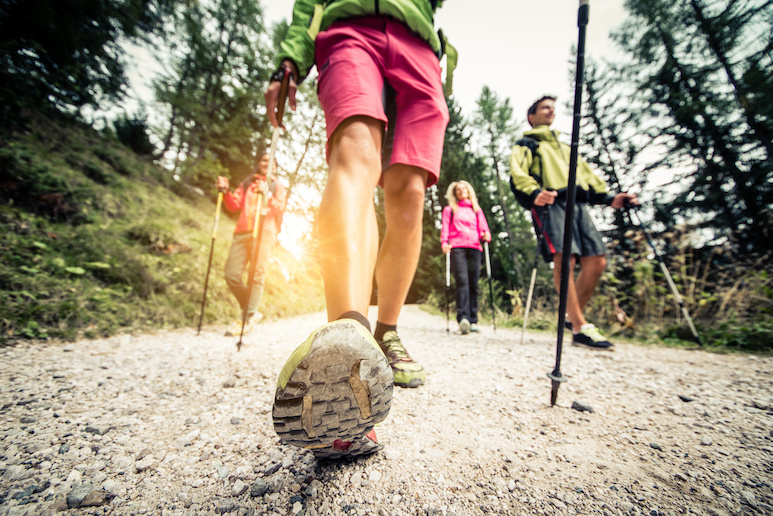
One of the key things to get right is the height of the poles. Whether you have fixed length or adjustable poles, it’s important that they are at the correct height for you.
Nordic poles come with attached glove-style straps so that the poles are almost an extension of your arm.
When you’ve got the gloves on and are holding the handle, your arm should be at right angles to your body or slightly below.
If your arm is higher or lower, you’ll need to adjust your poles.
Most Nordic walkers start off on flat ground. Once you’ve got the hang of the technique, you’ll be able to tackle rough terrain and steeper gradients.
You may also find that you need to adjust the height of poles as you become better at walking, since your posture may well improve.
3 fun places to try Nordic walking in Scandinavia
You don’t have to head far out of the city to try Nordic walking.
We like this guided Nordic walking tour of Töölönlahti Bay, that starts from the Oodi Library in the centre of Helsinki.
Nordic poles are provided, as is tuition of the basic techniques, so this is great for beginners.

And once you’ve mastered the technique, you can head off into the wilderness on your own with your Nordic poles.
The long-distance Kungsleden trail in Sweden is a particularly popular trail for Nordic walkers – see our guide for more details on this iconic trail.
In Norway, St Olav’s pilgrims’ way from Oslo to Trondheim is a fun route for Nordic walkers to tackle.
Community and resources
One of the best ways to go Nordic walking is to join a local group for support and motivation.
It’s a good idea to start off with lessons from an experienced guide so that you learn the correct technique from the get-go.
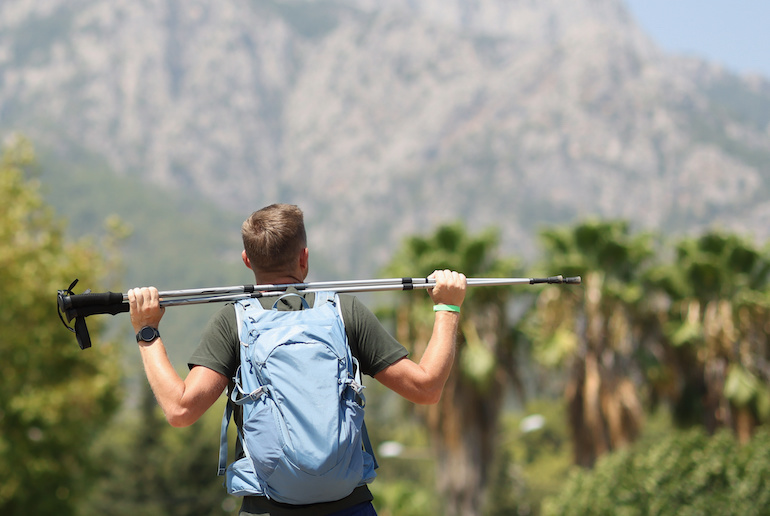
Then you can join a local group that runs weekly walks for extra motivation and companionship.
Nordic Walking UK and the American Nordic Walking Association are good places to start for links to various Nordic walking groups.
In the UK, the National Trust also runs free Nordic walking taster sessions at some of its properties around the country.
In Sweden, the Nordic Walking Academy has loads of advice and information on getting started with Nordic walking, plus tips on good places to go and high-performance work-outs once you’ve mastered the technique.
So, now you know what to do and where to go, what are waiting for? Why not give Nordic walking a go and try out the health benefits for yourself?
See also:
Where to go hiking near Stockholm
Hiking near Bergen
The best hiking trails in Sweden




